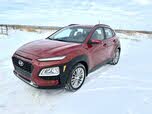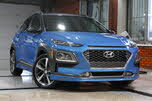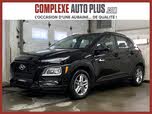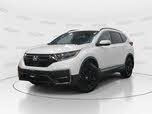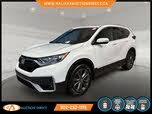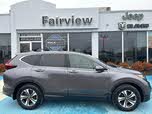2020 Hyundai Kona vs 2021 Honda CR-V
Overview | ||
MSRP | $20,300 | $25,350 |
Average price | $21,064 | $29,931 |
Listings | ||
Ratings & Reviews | ||
User reviews | ||
Expert reviews | 6.8 out of 10Read full review | 7.8 out of 10Read full review |
Pros & cons | Pros
| |
Summary | The Hyundai Kona subcompact SUV is one of the smallest cars you can buy with all-wheel drive. It competes in a class of four-door hatchbacks with the lifted suspensions and higher driving positions that crossover buyers want—and with the same generous list of convenience and safety features that come on larger crossovers. We last tested the Kona when it came out for 2018, but a new trim level and more standard driver assists are the major changes for 2020. For what Hyundai charges, the Kona is cramped and the interior disappoints, yet exterior style and on-road performance are spectacular. | Even in a grim year, Honda is selling a staggering number of CR-Vs. The CR-V is the best-selling Honda in Canada, edging out the home-built Honda Civic. The CR-V is also the second best-selling compact SUV, just behind the Toyota RAV4. And it was the sixth best-selling vehicle in Canada in 2021. So, it’s hard to argue against the CR-V formula. Honda’s been at this almost as long as crossovers have been a thing, launching the CR-V in 1997—a year after the RAV4 debuted. The funny thing is, aside from sales volume, there’s only one thing the CR-V particularly excels at. Aesthetics are subjective, but it would be hard to argue the CR-V is the best-looking vehicle in its class. It’s not the cheapest. It’s not the best equipped, especially at the middle to lower trim levels. It’s not the fastest, nor is it the quietest, or the most fuel efficient. It’s not even the most reliable, showing up nowhere in J.D. Power's Most Reliable list. So, what makes it so appealing to Canadian consumers? Let’s see if we can figure that out. |
Video | No video found | |
Popular Features & Specs | ||
Engine | 2.0L 147 hp I4 | 1.5L 190 hp I4 |
Drive Train | FWD | FWD |
Seating Capacity | 5 | 5 |
Horsepower | 147 hp @ 6200 rpm | 190 hp @ 5600 rpm |
MPG City | 27 | 28 |
MPG Highway | 33 | 34 |
Engine | ||
Engine Name | 2.0L 147 hp I4 | 1.5L 190 hp I4 |
Torque | 132 lb-ft @ 4500 rpm | 179 lb-ft @ 2000 rpm |
Horsepower | 147 hp @ 6200 rpm | 190 hp @ 5600 rpm |
Drivetrain | FWD | FWD |
Fuel Economy | ||
MPG City | 27 | 28 |
MPG Highway | 33 | 34 |
Interior | ||
Seating Capacity | 5 | 5 |
Safety | ||
Front Crash Overall | 5 | 5 |
Side Crash Overall | 5 | 5 |
Dimensions & Capacity | ||
Cargo Space | 19.2 cu ft | 39.2 cu ft |
Curb Weight | 2890 lbs | 3337 lbs |
Height | 61.0 in | 66.1 in |
Length | 164.0 in | 182.1 in |
Width | 70.9 in | 73.0 in |
Wheelbase | 102.4 in | 104.8 in |
Maximum Payload | 1089 lbs | 1358 lbs |
Number of doors | 4 | 4 |
Maximum Towing Capacity | 1500 lbs | |
The 2020 Hyundai Kona was a standout in the compact crossover segment with its sleek, sporty, and dramatic exterior design. It was larger than the Ford EcoSport, yet it managed to maintain a compact footprint that was visually stimulating. The Kona's design featured tiered lighting, a tall grille, and chunky matte plastic trim, which made it appear taller and wider. The slim LED running lamps, headlights spaced to the car's edges, and optional fog lights added to its dynamic look. The Kona's exterior was further enhanced by two-tone alloy wheels, a gently sloping roof, and a ground-hugging stance, giving it a premium vibe from every angle. However, the interior did not match the exterior's excitement, with hard plastics and lackluster finishes, making it less appealing compared to competitors like the Mazda CX-30 and Honda HR-V.
In contrast, the 2021 Honda CR-V had a more conventional design that blended in with other compact crossovers. While it lacked distinctive styling, it offered a few unique details like the grille opening and chromed plastic features. The CR-V was available in seven colours, though most were shades of gray, black, or white, with limited options for more vibrant hues. Inside, the CR-V provided a modern look with angular seats and upscale materials like wood panels and chrome, especially in higher trims. Despite its understated exterior, the CR-V's interior was functional and comfortable, making it a practical choice for families.
The 2020 Hyundai Kona surprised many with its impressive powertrain and chassis. Its 1.6-litre turbocharged inline-four engine delivered 175 horsepower and 195 pound-feet of torque, outperforming most competitors in the segment. The 7-speed dual-clutch transmission provided strong acceleration and confidence when merging onto highways. However, only the Trend and Ultimate trims featured the turbo engine, while the standard 2.0-litre engine offered 147 horsepower and 132 lb-ft of torque. The Kona's handling was commendable, with fast steering, stable suspension, and minimal roll, making it comparable to luxury models like the Mercedes-Benz GLA. Despite its performance, the Kona's fuel efficiency was average, with an estimated 8.6 L/100 km combined for the turbo AWD model.
The 2021 Honda CR-V offered a smooth and steady driving experience with its 1.5-litre turbo four-cylinder engine, producing 190 horsepower. While not the fastest in its class, the CR-V provided reliable acceleration and predictable cornering. All trims featured a continuously variable transmission (CVT), which prioritized efficiency over engagement. The CR-V's suspension setup, with MacPherson struts in the front and a multi-link rear, ensured decent handling and ride quality. The CR-V's fuel efficiency was competitive, and it offered both front-wheel drive and all-wheel drive options, with AWD standard on higher trims.
The 2020 Hyundai Kona struggled with interior space, offering seating for four and limited cargo capacity. With 544 litres of cargo space and 1,296 litres with the rear seats folded, it lagged behind competitors like the Honda HR-V and Kia Soul. The Kona's controls were user-friendly, and its infotainment system was straightforward, but it fell short as a utility vehicle, feeling more like a small hatchback than a true crossover.
The 2021 Honda CR-V excelled in interior space and functionality, comfortably seating five passengers and offering ample cargo capacity. With 1,065 litres of cargo volume with the rear seats folded, it could accommodate a significant amount of luggage. The CR-V's tailgate options, including a hands-free power tailgate on higher trims, added convenience. Roof rails were standard on most trims, enhancing its practicality for carrying additional gear.
The 2020 Hyundai Kona came equipped with a 7-inch touchscreen, Apple CarPlay, Android Auto, and Bluetooth as standard features. Higher trims added a sunroof, adaptive cruise control, and an 8-inch touchscreen with navigation. The Kona's lane-centring abilities impressed, although it lacked some advanced features found in more expensive models.
The 2021 Honda CR-V featured a 7-inch high-definition touchscreen infotainment system with Bluetooth, Apple CarPlay, and Android Auto. Lower trims had varying audio setups, while the Touring trim offered a 300-watt system with a subwoofer. The CR-V provided multiple charging ports, including USB and 12-volt outlets, with a wireless phone charger available on the Touring trim.
The 2020 Hyundai Kona received a five-star overall rating from the NHTSA and was named a 2020 Top Safety Pick by the IIHS. It offered standard safety features like forward emergency braking, lane-keep assist, and a driver attention monitor. However, it lacked front knee airbags and rear side airbags, and pedestrian detection was only available on the Ultimate trim.
The 2021 Honda CR-V excelled in safety, earning a five-star NHTSA rating and an IIHS Top Safety Pick award. It featured the Honda Sensing system, which included a suite of advanced safety features as standard across all trims. These features included a multi-angle rearview camera, forward collision warning, lane departure warning, and adaptive cruise control. The only feature not standard on the base LX trim was blind spot monitoring, which was available on higher trims.
CarGurus highlights

According to CarGurus experts, the overall rating for the 2020 Hyundai Kona is 6.8 out of 10, while the 2021 Honda CR-V scores 7.8 out of 10. Based on these ratings, the 2021 Honda CR-V is the recommended choice, offering superior safety features, interior space, and practicality for families.
Choose the 2020 Hyundai Kona if:
Shop Now- You prioritize a sporty and dynamic exterior design.
- You seek a powerful turbocharged engine for strong acceleration.
- You value a compact vehicle with user-friendly controls and infotainment.
Choose the 2021 Honda CR-V if:
Shop Now- You need ample interior space and cargo capacity for family and gear.
- You prioritize safety with a comprehensive suite of standard features.
- You prefer a smooth and steady driving experience with reliable performance.

By: CarGurus + AI
At CarGurus, our team of experienced automotive writers remain at the heart of our content operation, conducting hands-on car tests and writing insightful guides that are backed by years of industry experience. To complement this, we are harnessing AI to make our content offering more diverse and more helpful to shoppers than ever. To achieve this, our AI systems are based exclusively on CarGurus content, ratings and data, so that what we produce is both unique to CarGurus, and uniquely helpful to car shoppers.












